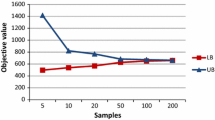Abstract
The stochastic nature of emergency service requests and the unavailability of emergency vehicles when requested to serve demands are critical issues in constructing valid models representing real life emergency medical service (EMS) systems. We consider an EMS system design problem with stochastic demand and locate the emergency response facilities and vehicles in order to ensure target levels of coverage, which are quantified using risk measures on random unmet demand. The target service levels for each demand site and also for the entire service area are specified. In order to increase the possibility of representing a wider range of risk preferences we develop two types of stochastic optimization models involving alternate risk measures. The first type of the model includes integrated chance constraints (ICCs ), whereas the second type incorporates ICCs and a stochastic dominance constraint. We develop solution methods for the proposed single-stage stochastic optimization problems and present extensive numerical results demonstrating their computational effectiveness.
Similar content being viewed by others
References
Ball, M. O., & Lin, F. L. (1993). A reliability model applied to emergency service vehicle location. Operations Research, 41, 18–36.
Batta, R., Dolan, J. M., & Krishnamurthy, N. N. (1989). The maximal expected covering location problem: Revisited. Transportation Science, 23, 277–287.
Beraldi, P., & Bruni, M. E. (2009). A probabilistic model applied to emergency service vehicle location. European Journal of Operational Research, 158(1), 183–193.
Beraldi, P., Bruni, M. E., & Conforti, D. (2004). Designing robust emergency medical service via stochastic programming. European Journal of Operational Research, 196, 323–331.
Berman, O., & Krass, D. (2001). Facility location problems with stochastic demands and congestion. In Z. Drezner & H. W. Hamacher (Eds.), Facility location: applications and theory (pp. 331–373). New York: Springer.
Brotcorne, L., Laporte, G., & Semet, F. (2003). Ambulance location and relocation models. European Journal of Operational Research, 147, 451–463.
Daskin, M. S. (1983). A maximum expected covering location model: formulation, properties and heuristic solution. Transportation Science, 17(1), 48–70.
Daskin, M. S. (1995). Network and discrete location: models, algorithms and applications. New York: Wiley.
Dentcheva, D., & Ruszczyński, A. (2003). Optimization with stochastic dominance constraints. SIAM Journal on Optimization, 14, 548–566.
Dentcheva, D., & Ruszczyński, A. (2006). Portfolio optimization with first order stochastic dominance constraints. Journal of Banking and Finance, 30(2), 433–451.
Erkut, E., Ingolfsson, A., & Erdogan, G. (2008a). Ambulance location for maximum survival. Naval Research Logistics Quarterly, 55(1), 42–58.
Erkut, E., Ingolfsson, A., & Budge, S. (2008b). Maximum availability/reliability models for selecting ambulance station and vehicle locations: a critique. Working paper. Available from http://www.business.ualberta.ca/aingolfsson/publications.htm.
Felder, S., & Brinkmann, H. (2002). Spatial allocation of emergency medical services: minimizing the death rate or providing equal access? Regional Science and Urban Economics, 32(1), 27–45.
Fourer, R., Gay, D. M., & Kernighan, B. W. (1993). AMPL: a modelling language for mathematical programming. San Francisco: Scientific Press.
Gendreau, M., LaPorte, G., & Semet, F. (1997). Solving an ambulance location model by tabu search. Location Science, 5(2), 75–88.
Goldberg, J. B. (2004). Operations research models for the deployment of emergency services vehicles. EMS Management Journal, 1(1), 20–39.
Hadar, J., & Russell, W. (1969). Rules for ordering uncertain prospects. The American Economic Review, 59, 25–34.
ILOG (2006). ILOG AMPL CPLEX system version 10.0 user’s guide. ILOG CPLEX Division.
Ingolfsson, A., Budge, S., & Erkut, E. (2008). Optimal ambulance location with random delays and travel times. Health Care Management Science, 11(3), 262–274.
Klein Haneveld, W. K. (1986). Duality in stochastic linear and dynamic programming. Lecture notes in economics and mathematical systems, vol. 274. New York: Springer.
Klein Haneveld, W. K., & Van Der Vlerk, M. H. (2006). Integrated chance constraints: reduced forms and an algorithm. Computational Management Science, 3(4), 245–269.
Lehmann, E. (1955). Ordered families of distributions. Annals of Mathematical Statistics, 26, 399–419.
Levy, H. (1992). Stochastic dominance and expected utility: survey and analysis. Management Science, 38, 555–593.
Louveaux, F. V. (1986). Discrete stochastic location models. Annals of Operation Research, 6, 23–34.
Louveaux, F. V. (1993). Stochastic location analysis. Location Science, 1(2), 127–154.
Luedtke, J. (2008). New formulations for optimization under stochastic dominance constraints. SIAM Journal on Optimization, 19(3), 1433–1450.
Luedtke, J., Ahmed, S., & Nemhauser, G. (2010). An integer programming approach for linear programs with probabilistic constraints. Mathematical Programming. Series A, 122(2), 247–272.
Mann, H. B., & Whitney, D. R. (1947). On a test of whether one of two random variables is stochastically larger than the other. Annals of Mathematical Statistics, 18, 50–60.
Marianov, V., & ReVelle, C. (1995). Siting emergency services. In Z. Drezner (Ed.), Facility location: a survey of applications and methods. Berlin: Springer.
Marsh, M., & Schilling, D. (1994). Equity measurement in facility location analysis: a review and framework. European Journal of Operational Research, 74(1), 1–17.
Müller, A., & Stoyan, D. (2002). Comparison methods for stochastic models and risks. Chichester: Wiley.
Noyan, N., & Prékopa, A. (2006). A variant of the Hungarian inventory control model. International Journal of Production Economics, 103, 784–797.
Owen, S. H., & Daskin, M. S. (1998). Strategic facility location: a review. European Journal of Operational Research, 111(3), 423–447.
Prékopa, A. (1973). Contributions to the theory of stochastic programming. Mathematical Programming, 4, 202–221.
Prékopa, A. (1995). Stochastic programming. Dordrecht: Kluwer Academic.
ReVelle, C., & Hogan, K. (1989). The maximum availability location problem. Transportation Science, 23, 192–200.
Snyder, L. V. (2006). Facility location under uncertainty: a review. IIE Transactions, 38(7), 537–554.
Author information
Authors and Affiliations
Corresponding author
Rights and permissions
About this article
Cite this article
Noyan, N. Alternate risk measures for emergency medical service system design. Ann Oper Res 181, 559–589 (2010). https://doi.org/10.1007/s10479-010-0787-x
Published:
Issue Date:
DOI: https://doi.org/10.1007/s10479-010-0787-x




